A Context Aware Smart Classroom Architecture for Smart Campuses
Abstract
:1. Introduction
- The availability of connected devices and sensors
- The ability to collect, store, and process data
- An understanding of what the data is and how it can be used
- A set of goals to benefit the recipients in making use of the data
- Mobile and web applications;
- Intelligent systems and technologically advanced devices;
- Data analysis and decision Support;
- Storage and backup;
- Connectivity;
- Cyber security;
- Platforms.
1.1. Background and Related Works
1.1.1. Physical Environment and Smart Classrooms
1.1.2. Technologies in Smart Classrooms
- Raspberry Pi [7]: Raspberry Pi Foundation, which is a UK-based charity, starts to build a series of low-cost, high-performance palm-size computer boards for teaching computer-related subjects since 2012. Raspberry Pi single board computers become very popular because of its price, quality, compatibility, documentation, and community support. In our proposed model, Raspberry Pi is used to integrate hardware devices, which have various kinds of interfaces, and provide web application interfaces for high-level applications.
- Python [37]: Python is a very popular general purpose computer programming language. The official operating system of Raspberry Pi provides a built-in python development environment, and official documents of Raspberry Pi provide a massive amount of example of using Python to get things done. Therefore, Python is used in this work to develop device control procedures and web application interfaces on Raspberry Pi boards.
- Flask [38]: Flask is one of the most popular Python web application frameworks. With Flask, which is a lightweight framework, things are simple, and developers can start to build web applications without installing many packages and configuration. Therefore, prototype implementation and proof of concepts can be done quickly, and researchers start to use Flask in research projects [39,40,41,42,43,44,45,46,47] in recent years. In this study, we use Flask as the web framework to build web application interfaces in Python on Raspberry Pi computers.
- PHP [48]: PHP, which stands for PHP: Hypertext Preprocessor, is one of the most popular general-purpose scripting languages for server-side web application development. PHP is capable of processing heavy-duty web transactions, and according to [49], many important websites, such as Facebook, Wikipedia, Yahoo, and WordPress, are using PHP as the major back-end web technology. In this study, PHP is used in the central web server to build applications on top of the web application interfaces provided by the Raspberry Pi computers, which are located in smart classrooms.
- MariaDB [50]: MariaDB is one of the most popular open-source relational database management system (RDBMS) in the world. It’s forked from MySQL [51] and guaranteed to stay open source. MariaDB intends to maintain high compatibility with MySQL. Therefore, a large number of PHP web applications can switch the back-end database from MySQL to MariaDB without much code modification. In this study, MariaDB is installed on the central web server and used as the back-end database to support PHP web applications.
- RFID: RFID is a wireless communication technology that uses radio frequency (RF) waves to transfer identifying information between tagged objects and readers without line of sight. Passive RFID can track products in supply chains from the supplier to the distribution center, warehouse, and point of sale [52]. Radio-frequency identification (RFID) has become one of the most widely used technologies in the world, and our life is full of RFID application, such as small payments, transportation, car access control, and door access control. In this study, RFID tag is used as the identification card in the door access control application.
- RS232 and RS485: RS232 and RS485 are standards defining the electrical characteristics in serial communications systems. The RS-232 standard had been commonly used in computer serial ports for connections to peripheral devices, such as modems, printers, computer mice, uninterruptible power supplies. RS485 can be used effectively over long distances and in electrically noisy environments. Multiple receivers may be connected to such a network in a linear, multidrop bus. Therefore, RS485 is often used in industrial control systems [53,54]. In smart place applications, most commercial controllable devices are providing control functions through RS485 and RS232.
1.1.3. Context-Aware and Energy Saving Related Studies
1.1.4. The MCU Smart Classroom Project
- A 1080P laser projector
- Two large touch interactive boards
- Projector and interactive boards have wireless display capability for mobile devices
- Touch screen for the teacher computer
- RFID based Door access control
- A Wall mount digital information board for dynamic classroom schedule and other applications
- An AI service chatbot in the digital information board
- Almost all devices in this classroom can be controlled by a computer program
- Sensors for collecting environment parameters
- Environment parameters are monitored, and devices’ operations in this classroom will be triggered by certain environment parameters
- All chairs for students are swivel tablet chairs for different types of lecturing and group discussion.
- All light sets can be controlled individually
- Several predefined classroom modes, which are combinations of control actions to lights, projector, projector screen, and interactive boards, are provided for users to control multiple classroom devices in one click for different classroom scenarios
- All the devices can be controlled in this classroom can be controlled by teachers computer and mobile phone
- Predefined classroom modes can be triggered by voice and classroom schedule
1.1.5. IoT, Fog and Cloud Computing
1.1.6. Smart Campus
2. Our Proposed Context-Aware Smart Classroom Architecture
2.1. The Context-Aware Smart Classroom Prototype
2.1.1. Basic Requirements of a Technology-Rich Classroom
- Basic requirements for a comfortable teaching and learning environment, as shown in Figure 1 and Figure 2.
- Whiteboards or blackboards for traditional lecturing.
- A lectern or a table for teacher.
- Swivel tablet chairs for different lecture style.
- Fans for air circulation.
- Air conditioner for temperature control.
- Lights should be divided into several sets with independent power switch.
- Basic requirements for teaching with digital lecture material, as shown in Figure 3.
- A general purpose personal computer with popular operating system and software applications installed and Internet connectivity.
- The computer is connected to at least two displays. One for controlling the computer, the other is a large screen for all audience.
- The computer controlling display should have the multi-touch function for teachers to put marks with fingers on the displayed contents during a lecture.
- Microphone for lecturing or presentation.
- An audio speaker which takes both the computer’s audio and microphone as a sound input source.
- Video/audio switches for devices such as a notebook computer or DVD player.
2.1.2. From a Technology-Rich Classroom to a Smart Classroom
- Device control, as shown in Figure 4
- Doors with controllable locks and access system based on ID cards or biometrics.
- Every device in the smart classroom should be remotely controllable, at least ON and OFF.
- There should be an all-in-one user interface for people in the classroom to control the devices in the classroom.
- Advanced interaction experience, as shown in Figure 5
- Besides the main large screen for lecturing, at least one more large screen with interactive function for group discussion and presentation.
- The extra-large screens are not only for interaction activities but also better audience experience when the classroom size is large. Therefore, a software or hardware solution for synchronizing contents between large screens is needed.
- Wireless display function for projecting contents to large screens from mobile devices
- Image and audio recording, as shown in Figure 6
- At least two cameras, one points to dais or lectern while the other points to the audience for distance learning.
- Software or hardware to record the teacher’s computer desktop.
- Images from cameras and computer desktop can be recorded or live cast depending on the smart classroom applications such as tele-education, webinar, courseware making, class monitoring, security, attendance management, lecture quality evaluation, and other image-based AI functions.
2.1.3. Smart Classroom with Context Awareness
- An information board to show classroom context
- Classroom schedule should be shown in the information board. Therefore, as shown in Figure 4a, the information about the classroom schedule is always correct even if a class is canceled or moved to another classroom.
- Classroom physical environment parameters, such as CO2 level, humidity, and temperature, can be shown in the information board, as shown in Figure 7.
- Control actions should link to backend school information systems to get user context related to the classroom.
- When the classroom is empty according to the correct classroom schedule from the school information system, classroom door should be locked and all devices, except controlling devices, should be turned off automatically to reduce energy consumption.
- When the classroom is not empty according to the correct classroom schedule from the school information system, classroom door should be unlocked automatically and keep unlocked until the class is over.
- The door access system should link to teachers and students’ private class schedule. Teachers and students who get to the classroom before the class can unlock the door and turn devices on with ID cards.
- When a user passes the door access system, devices in the classroom, which are essential to a class, should be turned on automatically.
- Environment parameters related to teaching and learning performance should link to control actions
- CO2 level triggers or suggests exhaust fan actions.
- Temperature and humidity trigger or suggest air conditioner actions.
- Illumine triggers or suggests light control actions.
2.2. The Smart Classroom Technology Integration Model
- Layer 1: The Device Integration Layer
- Layer 2: The Basic Operation Layer
- Layer 3: The Combo Operation Layer
- Layer 4: The Smart Classroom Application Layer
2.3. Supporting Measures for the Proposed Architecture
- Device control network, which is layer 1 and layer 2 in the model, and normal network, which is layer 3 or layer 4 in the model, should be at least logically separated in smart classrooms.
- Every classroom should have its own private network for device control, and the configuration of the private network in every classroom should be identical.
- It is recommended to use Secure Sockets Layer (SSL) encryption to protect web application interface calls.
- It is recommended to implement mechanisms such as API keys for controlling access to layer 2 and layer 3 operations.
- It is recommended to implement or set IP and port-based access control rules for controlling access to web application interface calls.
- It is recommended to take software-based Network address translation (NAT) solutions for private network gateway in each classroom for providing flexibility and convenience of future configuration.
- It is recommended to implement auto registration functions on Raspberry Pi boards for auto-registering layer 2 operations to the central web server.
3. An Implementation of the Proposed Architecture
- A projector
- A motorized projector screen
- Four light sets which can be controlled separately
- Doors with electromagnetic locks
- RFID based door access control
- An exhaust fan
- An air conditioner
- A sensor for CO2 level and temperature
- A wall mount interactive board
- Three Raspberry Pi boards for device control
- An IP NAT gateway
- A Web Server in the university network
- Raspberry Pi 01: IP address is 192.168.50.2. The projector, projector screen, all four light sets are controlled by Raspberry Pi 01.
- Raspberry Pi 02: IP address is 192.168.50.3. The interactive board and the environment sensors are controlled by Raspberry Pi 02.
- Raspberry Pi 03: IP address is 192.168.50.4. The RFID tag reader is connected to Raspberry Pi 03. Doors, air conditioner, and exhaust fan are controlled by Raspberry Pi 03.
- NAT Gateway: The private network of the sample smart classroom is 192.168.50.0/24. The IP address of the network interface connecting to the private network is 192.168.50.1. The IP address of the network interface connecting to the university network is 10.0.0.1.
- Web Server: The web server is located in the university network. The IP address of the web server is 172.16.1.1
3.1. Device Integration Layer and Basic Operation Layer
3.2. Combo Operation Layer and Smart Classroom Application Layer
3.3. Context-Aware Energy-Saving Smart Classroom Applications
3.4. In-Campus Facial Recognition Service Integration
3.5. Implementation of the Proposed Supporting Measures.
4. Conclusions
Author Contributions
Funding
Acknowledgments
Conflicts of Interest
Appendix A
| Device | L1 Device Control Path | Controller |
|---|---|---|
| Projector | [Projector][RS232]===[RS232][Adapter][USB]===[USB][RPi] | RPi-01 |
| Screen | [Motor Unit][RS232]===[RS232][Adapter][USB]===[USB][RPi] | RPi-01 |
| Light 01 | [Light][110V]===[110V][Relay Mod][3.3V]===[GPIO][RPi] | RPi-01 |
| Light 02 | [Light][110V]===[110V][Relay Mod][3.3V]===[GPIO][RPi] | RPi-01 |
| Light 03 | [Light][110V]===[110V][Relay Mod][3.3V]===[GPIO][RPi] | RPi-01 |
| Light 04 | [Light][110V]===[110V][Relay Mod][3.3V]===[GPIO][RPi] | RPi-01 |
| Inter. Board | [Inter. Board][110V]===[110V][Relay Mod][TCP]===[TCP][RPi] | RPi-02 |
| Temp. Sensor | [Sensor][RS485]==[RS485][Serial Gateway][ModBus]===[ModBus][RPi] | RPi-02 |
| CO2 Sensor | [Sensor][RS485]==[RS485][Serial Gateway][ModBus]===[ModBus][RPi] | RPi-02 |
| Fan | [Fan][110V]===[110V][Relay Mod][TCP]===[TCP][RPi] | RPi-03 |
| Air Con. | [Air Con][RS485]==[RS485][Serial Gateway][ModBus]===[ModBus][RPi] | RPi-03 |
| Door | [EM Lock][110V]===[110V][Relay Mod][3.3V]===[GPIO][RPi] | RPi-03 |
| RFID Reader | [RFID Reader][USB]==>[USB][RPi] | RPi-03 |
| Room ID | Controller | Ext. IP | Ext. Port | Dir. | Private IP | Service Port |
|---|---|---|---|---|---|---|
| H204 | RPi-01 | 10.0.0.1 | 5001 | ➔ | 192.168.50.2 | 5000 |
| H204 | RPi-02 | 10.0.0.1 | 5002 | ➔ | 192.168.50.3 | 5000 |
| H204 | RPi-03 | 10.0.0.1 | 5003 | ➔ | 192.168.50.4 | 5000 |
| Room ID | L3 OP ID | Combo Operation | L3 Operation and the Corresponding L2 Operations |
|---|---|---|---|
| H204 | C0001 | Turn On Everything | Layer 3: https://172.16.1.1/combo/H204/C001 Layer 2: Projector on: {H204,Projector,Power on} Screen down: {H204,Screen,Scroll down} Light 01 on: {H204,Light 01,Power on} Light 02 on: {H204,Light 02,Power on} Light 03 on: {H204,Light 03,Power on} Light 04 on: {H204,Light 04,Power on} Interactive board on: {H204,Inter. Board,Power on} Air Con on: {H204,Air Con,Power on} Fan on: {H204,Fan,Power on} |
| H204 | C0002 | Use Projector | Layer 3: https://172.16.1.1/combo/H204/C002 Layer 2: Projector on: {H204,Projector,Power on} Screen down: {H204,Screen,Scroll down} Light 01 off: {H204,Light 01,Power off} Light 02 on: {H204,Light 02,Power on} Light 03 on: {H204,Light 03,Power on} Light 04 on: {H204,Light 04,Power on} Interactive board off: {H204,Inter. Board,Power off} |
| H204 | C0003 | Use Whiteboard | Layer 3: https://172.16.1.1/combo/H204/C003 Layer 2: Projector off: {H204,Projector,Power off} Screen up: {H204,Screen,Scroll up} Light 01 on: {H204,Light 01,Power on} Light 02 on: {H204,Light 02,Power on} Light 03 on: {H204,Light 03,Power on} Light 04 on: {H204,Light 04,Power on} Interactive board off: {H204,Inter. Board,Power off} |
| H204 | C0004 | Use Interactive Board without Projector | Layer 3: https://172.16.1.1/combo/H204/C004 Layer 2: Projector off: {H204, Projector, Power off} Screen up: {H204,Screen,Scroll up} Light 01 on: {H204,Light 01,Power on} Light 02 off: {H204,Light 02,Power off} Light 03 on: {H204,Light 03,Power on} Light 04 on: {H204,Light 04,Power on} Interactive board on: {H204,Inter. Board,Power on} |
| H204 | C0005 | Turn Off Everything | Layer 3: https://172.16.1.1/combo/H204/C005 Layer 2: Projector off: {H204 Projector, Power off} Screen off: {H204,Screen,Scroll up} Light 01 off: {H204,Light 01,Power off} Light 02 off: {H204,Light 02,Power off} Light 03 off: {H204,Light 03,Power off} Light 04 off: {H204,Light 04,Power off} Interactive board off: {H204,Inter. Board,Power off} Air Con off {H204 Air Con, Power off} Fan off: {H204, Fan, Power off} |
References
- Muhamad, W.; Kurniawan, N.B.; Suhardi; Yazid, S. Smart campus features, technologies, and applications: A systematic literature review. In Proceedings of the 2017 International Conference on Information Technology Systems and Innovation (ICITSI), Bandung, Indonesia, 23–24 October 2017; pp. 384–391. [Google Scholar]
- Jisc Home Page. Available online: https://www.jisc.ac.uk/ (accessed on 24 April 2019).
- Guide to the Intelligent Campus. Available online: https://repository.jisc.ac.uk/6882/1/Intelligent_Campus_Guide.pdf (accessed on 24 April 2019).
- Malatji, E.M. The Development of a Smart Campus—African Universities Point of View. In Proceedings of the 2017 8th International Renewable Energy Congress (IREC), Amman, Jordan, 21–23 March 2017; pp. 1–5. [Google Scholar]
- John, T.M.; Ucheaga, E.G.; Badejo, J.A.; Atayero, A.A. A Framework for a Smart Campus: A Case of Covenant University. In Proceedings of the 2017 International Conference on Computational Science and Computational Intelligence (CSCI), Las Vegas, NV, USA, 14–16 December 2017; pp. 1371–1376. [Google Scholar]
- Alghamdi, A.; Shetty, S. Survey Toward a Smart Campus Using the Internet of Things. In Proceedings of the 2016 IEEE 4th International Conference on Future Internet of Things and Cloud (FiCloud), Vienna, Austria, 22–24 August 2016; pp. 235–239. [Google Scholar]
- Raspberry Pi Home Page. Available online: https://www.raspberrypi.org/ (accessed on 23 November 2018).
- Uzelac, A.; Gligoric, N.; Krco, S. System for recognizing lecture quality based on analysis of physical parameters. Telemat. Inform. 2018, 35, 579–594. [Google Scholar] [CrossRef]
- Uzelac, A.; Gligoric, N.; Krco, S. A comprehensive study of parameters in physical environment that impact students’ focus during lecture using Internet of Things. Comput. Hum. Behav. 2015, 53, 427–434. [Google Scholar] [CrossRef]
- Van De Bogart, W.; Wichadee, S. Students’ Perceived Effectiveness of Educational Technologies and Motivation in Smart Classroom. Tem J.-Technol. Educ. Manag. Inform. 2016, 5, 566–574. [Google Scholar] [CrossRef]
- Park, E.L.; Choi, B.K. Transformation of classroom spaces: Traditional versus active learning classroom in colleges. High. Educ. 2014, 68, 749–771. [Google Scholar] [CrossRef]
- Sardinha, L.; Almeida, A.M.P.; Pedro, N. Bridging approaches: Classroom Physical Space as a learning ecosystem. Interact. Des. Archit. 2017, 35, 56–74. [Google Scholar]
- Future Classroom Lab. Available online: http://www.eun.org/professional-development/future-classroom-lab (accessed on 20 December 2018).
- European Schoolnet Home Page. Available online: http://www.eun.org/home (accessed on 21 December 2018).
- Learning Zones of the Future Classroom Lab. Available online: http://fcl.eun.org/documents/10180/13526/FCL+learning+zones+Dec+2016/a091a761-7a63-443e-afe0-d1870e430686 (accessed on 21 December 2018).
- Dai, S.L. ARS Interactive Teaching Mode for Financial Accounting Course based on Smart Classroom. Int. J. Emerg. Technol. Learn. 2019, 14, 38–50. [Google Scholar] [CrossRef]
- Xie, W.; Shi, Y.; Xu, G.; Xie, D. Smart Classroom—An Intelligent Environment for Tele-education. In Proceedings of the Advances in Multimedia Information Processing—PCM 2001, Beijing, China, 24–26 October 2001; pp. 662–668. [Google Scholar]
- The Open Agent Architecture. Available online: http://www.ai.sri.com/~oaa/ (accessed on 14 October 2018).
- Mao, Y.; Xie, W.; Shi, Y.; Xu, G.; Xiang, X. Building the Software Infrastructure for Smart Classroom: From Open Agent Architecture (OAA) to Smart Platform. In Proceedings of the Advances in Multimedia Information Processing—PCM 2002, Hsinchu, Taiwan, 16–18 December 2002; pp. 526–533. [Google Scholar]
- Snow, C.; Pullen, J.M.; McAndrews, P. Network Education Ware: An open-source web-based system for synchronous distance education. IEEE Trans. Educ. 2005, 48, 705–712. [Google Scholar] [CrossRef]
- The Network Education Ware Project. Available online: https://netlab.gmu.edu/NEW/ (accessed on 13 December 2018).
- Qin, W.J.; Suo, Y.; Shi, Y.C. CAMPS: A middleware for providing context-aware services for Smart Space. In Advances in Grid and Pervasive Computing, Proceedings; Chung, Y.C., Moreira, J.E., Eds.; Springer: Berlin/Heidelberg, Germany, 2006; Volume 3947, pp. 644–653. [Google Scholar]
- Suo, Y.; Miyata, N.; Morikawa, H.; Ishida, T.; Shi, Y.C. Open Smart Classroom: Extensible and Scalable Learning System in Smart Space Using Web Service Technology. IEEE Trans. Knowl. Data Eng. 2009, 21, 814–828. [Google Scholar] [CrossRef] [Green Version]
- Shi, Y.C.; Xie, W.K.; Xu, G.Y.; Shi, R.; Chen, E.; Mao, Y.H.; Liu, F. The smart classroom: Merging technologies for seamless tele-education. IEEE Pervasive Comput. 2003, 2, 47–55. [Google Scholar] [CrossRef]
- Shen, C.W.; Wu, Y.C.J.; Lee, T.C. Developing a NFC-equipped smart classroom: Effects on attitudes toward computer science. Comput. Hum. Behav. 2014, 30, 731–738. [Google Scholar] [CrossRef]
- Al-Qirim, N. Determinants of interactive white board success in teaching in higher education institutions. Comput. Educ. 2011, 56, 827–838. [Google Scholar] [CrossRef]
- Tissenbaum, M.; Lui, M.; Slotta, J.D. Co-Designing Collaborative Smart Classroom Curriculum for Secondary School Science. J. Univers. Comput. Sci. 2012, 18, 327–352. [Google Scholar]
- Yang, J.F.; Yu, H.J.; Gong, C.H.; Chen, N.S. Students’ Perceptions and Behaviour in Technology-Rich Classroom and Multi-Media Classroom. Eurasia J. Math. Sci. Technol. Educ. 2017, 13, 621–647. [Google Scholar] [CrossRef]
- Teo, T. An initial development and validation of a Digital Natives Assessment Scale (DNAS). Comput. Educ. 2013, 67, 51–57. [Google Scholar] [CrossRef]
- Gul, S.; Asif, M.; Ahmad, S.; Yasir, M.; Majid, M.; Malik, M.S.A. A Survey on Role of Internet of Things in Education. Int. J. Comput. Sci. Netw. Secur. 2017, 17, 159–165. [Google Scholar]
- Chamba-Eras, L.; Aguilar, J. Augmented Reality in a Smart Classroom-Case Study: SaCI. IEEE Revista Iberoamericana De Tecnologias Del Aprendizaje IEEE Rita 2017, 12, 165–172. [Google Scholar] [CrossRef]
- Kim, Y.; Soyata, T.; Behnagh, R. Towards Emotionally Aware AI Smart Classroom: Current Issues and Directions for Engineering and Education. IEEE Access 2018, 6, 5308–5331. [Google Scholar] [CrossRef]
- Aguilar, J.; Sanchez, M.; Cordero, J.; Valdiviezo-Diaz, P.; Barba-Guaman, L.; Chamba-Eras, L. Learning analytics tasks as services in smart classrooms. Univers. Access Inf. Soc. 2018, 17, 693–709. [Google Scholar] [CrossRef]
- Gu, H.L.; Shi, Y.C.; Xu, G.Y.; Chen, Y. A core model supporting location-aware computing in smart classroom. In Advances in Web-Based Learning—ICWL 2005; Lau, R.W.H., Li, Q., Cheung, R., Liu, W., Eds.; Springer: Berlin/Heidelberg, Germany, 2005; Volume 3583, pp. 1–13. [Google Scholar]
- Pirahandeh, M.; Kim, D.H. Energy-aware and intelligent storage features for multimedia devices in smart classroom. Multimed. Tools Appl. 2017, 76, 1139–1157. [Google Scholar] [CrossRef]
- MacLeod, J.; Yang, H.H.; Zhu, S.; Li, Y.H. Understanding students’ preferences toward the smart classroom learning environment: Development and validation of an instrument. Comput. Educ. 2018, 122, 80–91. [Google Scholar] [CrossRef]
- Python Home Page. Available online: https://www.python.org/ (accessed on 12 October 2018).
- Flask microframework Home Page. Available online: http://flask.pocoo.org/ (accessed on 12 October 2018).
- Parikh, V.; Keskar, M.; Dharia, D.; Gotmare, P. A Tourist Place Recommendation and Recognition System. In Proceedings of the 2018 Second International Conference on Inventive Communication and Computational Technologies (ICICCT), Coimbatore, India, 20–21 April 2018; pp. 218–222. [Google Scholar]
- Nepomuceno, T.; Carneiro, T.; Carneiro, T.; Korn, C.; Martin, A. A GUI-based Platform for Quickly Prototyping Server-side IoT Applications. In Proceedings of the Smart SysTech 2018; European Conference on Smart Objects, Systems and Technologies, Munich, Germany, 12–13 June 2018; pp. 1–9. [Google Scholar]
- Kauling, D.; Mahmoud, Q.H. Sensorian Hub: An IFTTT-based platform for collecting and processing sensor data. In Proceedings of the 2017 14th IEEE Annual Consumer Communications & Networking Conference (CCNC), Las Vegas, NV, USA, 8–11 January 2017; pp. 504–509. [Google Scholar]
- Gharibi, G.; Alanazi, R.; Lee, Y. Automatic Hierarchical Clustering of Static Call Graphs for Program Comprehension. In Proceedings of the 2018 IEEE International Conference on Big Data (Big Data), Seattle, WA, USA, 10–13 December 2018; pp. 4016–4025. [Google Scholar]
- Tiankaew, U.; Chunpongthong, P.; Mettanant, V. A Food Photography App with Image Recognition for Thai Food. In Proceedings of the 2018 Seventh ICT International Student Project Conference (ICT-ISPC), Nakhonpathom, Thailand, 11–13 July 2018; pp. 1–6. [Google Scholar]
- Çelık, N.; Oğul, H. A web application for content based geographic image retrieval. In Proceedings of the 2017 25th Signal Processing and Communications Applications Conference (SIU), Antalya, Turkey, 15–18 May 2017; pp. 1–4. [Google Scholar]
- Singh, S.; Kaushik, A.; Chitkara, S.S. Ubiquitously controlled personalized smartlock. In Proceedings of the 2017 International Conference on I-SMAC (IoT in Social, Mobile, Analytics and Cloud) (I-SMAC), Palladam, India, 10–11 February 2017; pp. 686–691. [Google Scholar]
- Patil, S.M.; Vijayalashmi, M.; Tapaskar, R. IoT based solar energy monitoring system. In Proceedings of the 2017 International Conference on Energy, Communication, Data Analytics and Soft Computing (ICECDS), Chennai, India, 1–2 August 2017; pp. 1574–1579. [Google Scholar]
- Vogel, P.; Klooster, T.; Andrikopoulos, V.; Lungu, M. A Low-Effort Analytics Platform for Visualizing Evolving Flask-Based Python Web Services. In Proceedings of the 2017 IEEE Working Conference on Software Visualization (VISSOFT), Shanghai, China, 18–19 September 2017; pp. 109–113. [Google Scholar]
- PHP Home Page. Available online: https://www.php.net/ (accessed on 20 April 2019).
- Programming Languages Used in Most Popular Websites. Available online: https://en.wikipedia.org/wiki/Programming_languages_used_in_most_popular_websites (accessed on 22 April 2019).
- MariaDB Home Page. Available online: https://mariadb.org/ (accessed on 22 April 2019).
- MySQL Home Page. Available online: https://www.mysql.com/ (accessed on 22 April 2019).
- Mo, J.P.T.; Sheng, Q.Z.; Li, X.; Zeadally, S. RFID Infrastructure Design: A Case Study of Two Australian RFID Projects. IEEE Internet Comput. 2009, 13, 14–21. [Google Scholar] [CrossRef]
- RS-485. Available online: https://en.wikipedia.org/wiki/RS-485 (accessed on 22 April 2019).
- RS-232. Available online: https://en.wikipedia.org/wiki/RS-232 (accessed on 22 April 2019).
- Li, X.; Feng, L.; Zhou, L.Z.; Shi, Y.C. Learning in an Ambient Intelligent World: Enabling Technologies and Practices. IEEE Trans. Knowl. Data Eng. 2009, 21, 910–924. [Google Scholar] [CrossRef]
- Dutta, J.; Roy, S.; Chowdhury, C. Unified framework for IoT and smartphone based different smart city related applications. Microsyst. Technol.-Micro Nanosyst.-Inf. Storage Process. Syst. 2019, 25, 83–96. [Google Scholar] [CrossRef]
- Arduino Home. Available online: https://www.arduino.cc/ (accessed on 8 December 2018).
- Calvillo, C.F.; Sánchez-Miralles, A.; Villar, J. Energy management and planning in smart cities. Renew. Sustain. Energy Rev. 2016, 55, 273–287. [Google Scholar] [CrossRef]
- Carli, R.; Dotoli, M.; Pellegrino, R. A Hierarchical Decision-Making Strategy for the Energy Management of Smart Cities. IEEE Trans. Autom. Sci. Eng. 2017, 14, 505–523. [Google Scholar] [CrossRef]
- Blaauwbroek, N.; Nguyen, P.H.; Konsman, M.J.; Shi, H.; Kamphuis, R.I.G.; Kling, W.L. Decentralized Resource Allocation and Load Scheduling for Multicommodity Smart Energy Systems. IEEE Trans. Sustain. Energy 2015, 6, 1506–1514. [Google Scholar] [CrossRef]
- Carli, R.; Dotoli, M. A decentralized resource allocation approach for sharing renewable energy among interconnected smart homes. In Proceedings of the 2015 54th IEEE Conference on Decision and Control (CDC), Osaka, Japan, 15–18 December 2015; pp. 5903–5908. [Google Scholar]
- Brusco, G.; Burgio, A.; Menniti, D.; Pinnarelli, A.; Sorrentino, N. Energy Management System for an Energy District With Demand Response Availability. IEEE Trans. Smart Grid 2014, 5, 2385–2393. [Google Scholar] [CrossRef]
- Carli, R.; Dotoli, M. Cooperative Distributed Control for the Energy Scheduling of Smart Homes with Shared Energy Storage and Renewable Energy Source. IFAC-PapersOnLine 2017, 50, 8867–8872. [Google Scholar] [CrossRef]
- Figueiredo, J.; Sá da Costa, J. A SCADA system for energy management in intelligent buildings. Energy Build. 2012, 49, 85–98. [Google Scholar] [CrossRef] [Green Version]
- Carli, R.; Dotoli, M. Energy scheduling of a smart home under nonlinear pricing. In Proceedings of the 53rd IEEE Conference on Decision and Control, Los Angeles, CA, USA, 15–17 December 2014; pp. 5648–5653. [Google Scholar]
- Chiou, C.B.; Chiou, C.H.; Chu, C.M.; Lin, S.L. The study of energy-saving strategy for direct expansion air conditioning system. Energy Build. 2008, 40, 1660–1665. [Google Scholar] [CrossRef]
- Chung, M.H.; Rhee, E.K. Potential opportunities for energy conservation in existing buildings on university campus: A field survey in Korea. Energy Build. 2014, 78, 176–182. [Google Scholar] [CrossRef]
- Mahlia, T.M.I.; Razak, H.A.; Nursahida, M.A. Life cycle cost analysis and payback period of lighting retrofit at the University of Malaya. Renew. Sustain. Energy Rev. 2011, 15, 1125–1132. [Google Scholar] [CrossRef]
- Motta Cabrera, D.F.; Zareipour, H. Data association mining for identifying lighting energy waste patterns in educational institutes. Energy Build. 2013, 62, 210–216. [Google Scholar] [CrossRef]
- Ming Chuan University Official Website. Available online: https://web.mcu.edu.tw/en (accessed on 20 February 2019).
- Overview of the Internet of Things. Available online: http://handle.itu.int/11.1002/1000/11559 (accessed on 18 April 2019).
- Mell, P.; Grance, T. The NIST Definition of Cloud Computing; NIST, Ed.; NIST: Gaithersburg, MA, USA, 2011. [Google Scholar]
- Gubbi, J.; Buyya, R.; Marusic, S.; Palaniswami, M. Internet of Things (IoT): A vision, architectural elements, and future directions. Future Gener. Comput. Syst. 2013, 29, 1645–1660. [Google Scholar] [CrossRef] [Green Version]
- Lorga, M.; Feldman, L.; Barton, R.; Martin, M.J.; Goren, N.S.; Mahmoudi, C. Fog Computing Conceptual Model; NIST, Ed.; NIST: Gaithersburg, MA, USA, 2018. [Google Scholar]
- Bonomi, F.; Milito, R.; Zhu, J.; Addepalli, S. Fog computing and its role in the internet of things. In Proceedings of the first edition of the MCC workshop on Mobile cloud computing, Helsinki, Finland, 17 August 2012; pp. 13–16. [Google Scholar]
- Burt, J. Fog Computing Aims to Reduce Processing Burden of Cloud Systems. Available online: https://www.eweek.com/networking/fog-computing-aims-to-reduce-processing-burden-of-cloud-systems (accessed on 18 April 2019).
- Rahmani, A.; Thanigaivelan, N.K.; Tuan Nguyen, G.; Granados, J.; Negash, B.; Liljeberg, P.; Tenhunen, H. Smart e-Health Gateway: Bringing intelligence to Internet-of-Things based ubiquitous healthcare systems. In Proceedings of the 2015 12th Annual IEEE Consumer Communications and Networking Conference (CCNC), 9–12 January 2015; pp. 826–834. [Google Scholar]
- Rahmani, A.M.; Gia, T.N.; Negash, B.; Anzanpour, A.; Azimi, I.; Jiang, M.; Liljeberg, P. Exploiting smart e-Health gateways at the edge of healthcare Internet-of-Things: A fog computing approach. Future Gener. Comput. Syst. 2018, 78, 641–658. [Google Scholar] [CrossRef]
- Hentschel, K.; Jacob, D.; Singer, J.; Chalmers, M. Supersensors: Raspberry Pi Devices for Smart Campus Infrastructure. In Proceedings of the 2016 IEEE 4th International Conference on Future Internet of Things and Cloud (FiCloud), Vienna, Austria, 22–24 August 2016; pp. 58–62. [Google Scholar]
- Wang, Y.; Saez, B.; Szczechowicz, J.; Ruisi, J.; Kraft, T.; Toscano, S.; Vacco, Z.; Nicolas, K. A smart campus internet of things framework. In Proceedings of the 2017 IEEE 8th Annual Ubiquitous Computing, Electronics and Mobile Communication Conference (UEMCON), New York City, NY, USA, 19–21 October 2017; pp. 498–503. [Google Scholar]
- Narendrakumar, T.; Pillai, A.S. Smart connected campus. In Proceedings of the 2017 International Conference on Intelligent Computing, Instrumentation and Control Technologies (ICICICT), Kannur, Kerala, India, 6–7 July 2017; pp. 1591–1596. [Google Scholar]
- Haghi, A.; Burney, K.; Kidd, F.S.; Valiente, L.; Peng, Y. Fast-paced development of a smart campus IoT platform. In Proceedings of the 2017 Global Internet of Things Summit (GIoTS), Geneva, Switzerland, 6–9 June 2017; pp. 1–6. [Google Scholar]
- Xu, X.; Li, D.; Sun, M.; Yang, S.; Yu, S.; Manogaran, G.; Mastorakis, G.; Mavromoustakis, C.X. Research on Key Technologies of Smart Campus Teaching Platform Based on 5G Network. IEEE Access 2019, 7, 20664–20675. [Google Scholar] [CrossRef]
- Yang, A.; Li, S.; Ren, C.; Liu, H.; Han, Y.; Liu, L. Situational Awareness System in the Smart Campus. IEEE Access 2018, 6, 63976–63986. [Google Scholar] [CrossRef]
- International Conference on Smart Campus and Exhibition, iCSC&E. Available online: http://icsc.tku.edu.tw/ (accessed on 1 December 2018).
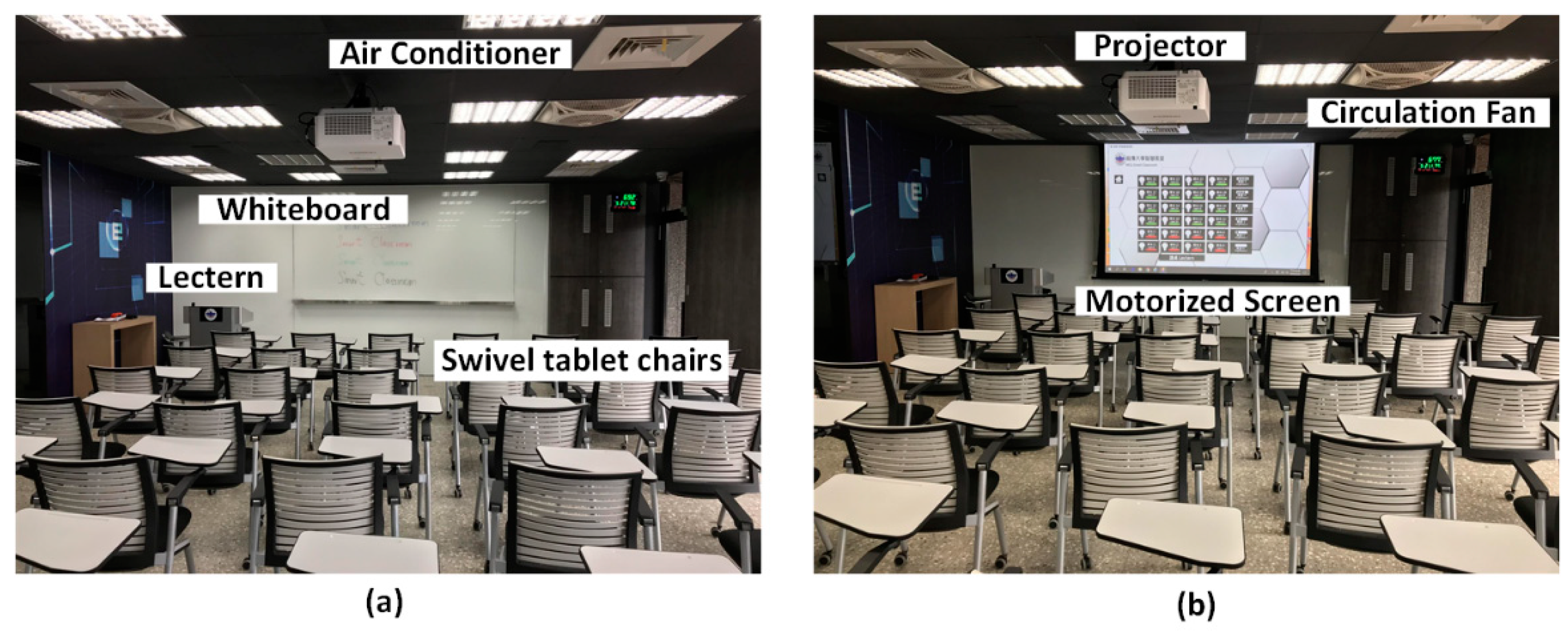
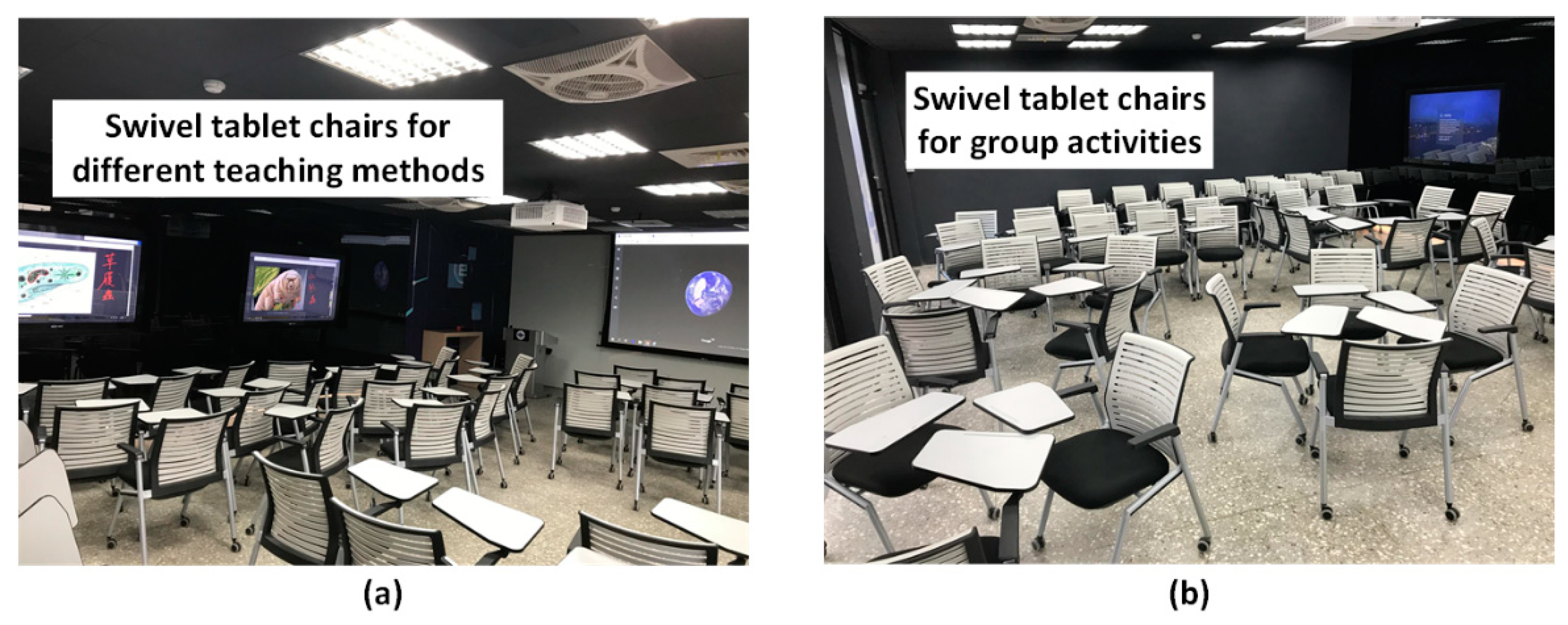
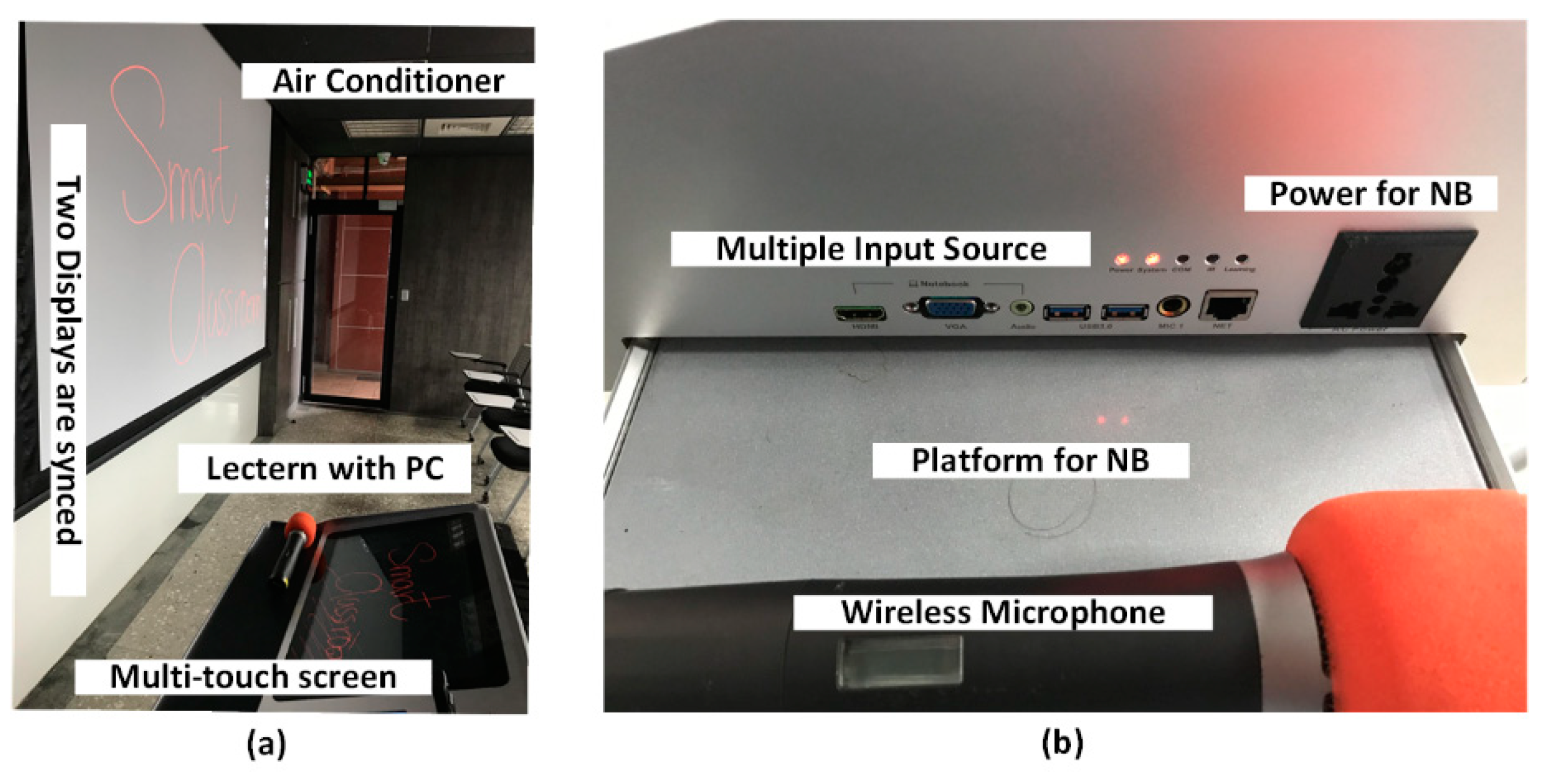

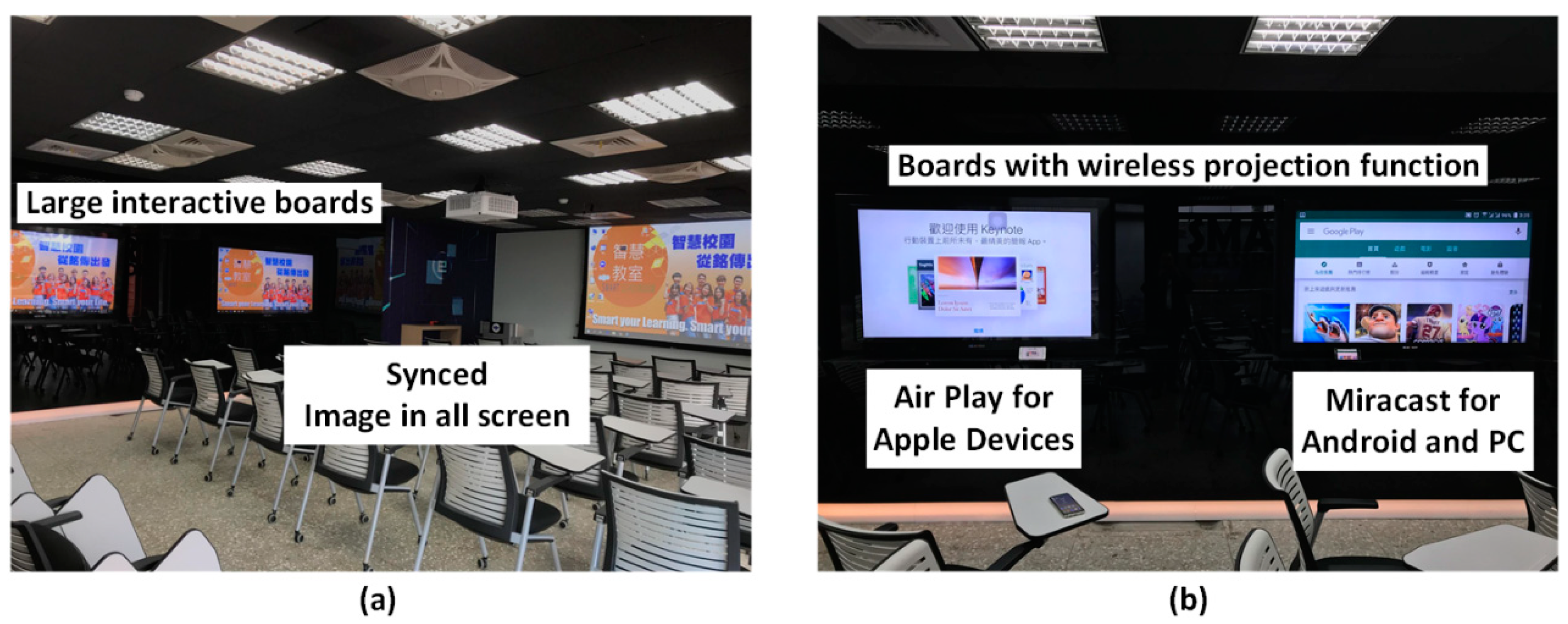





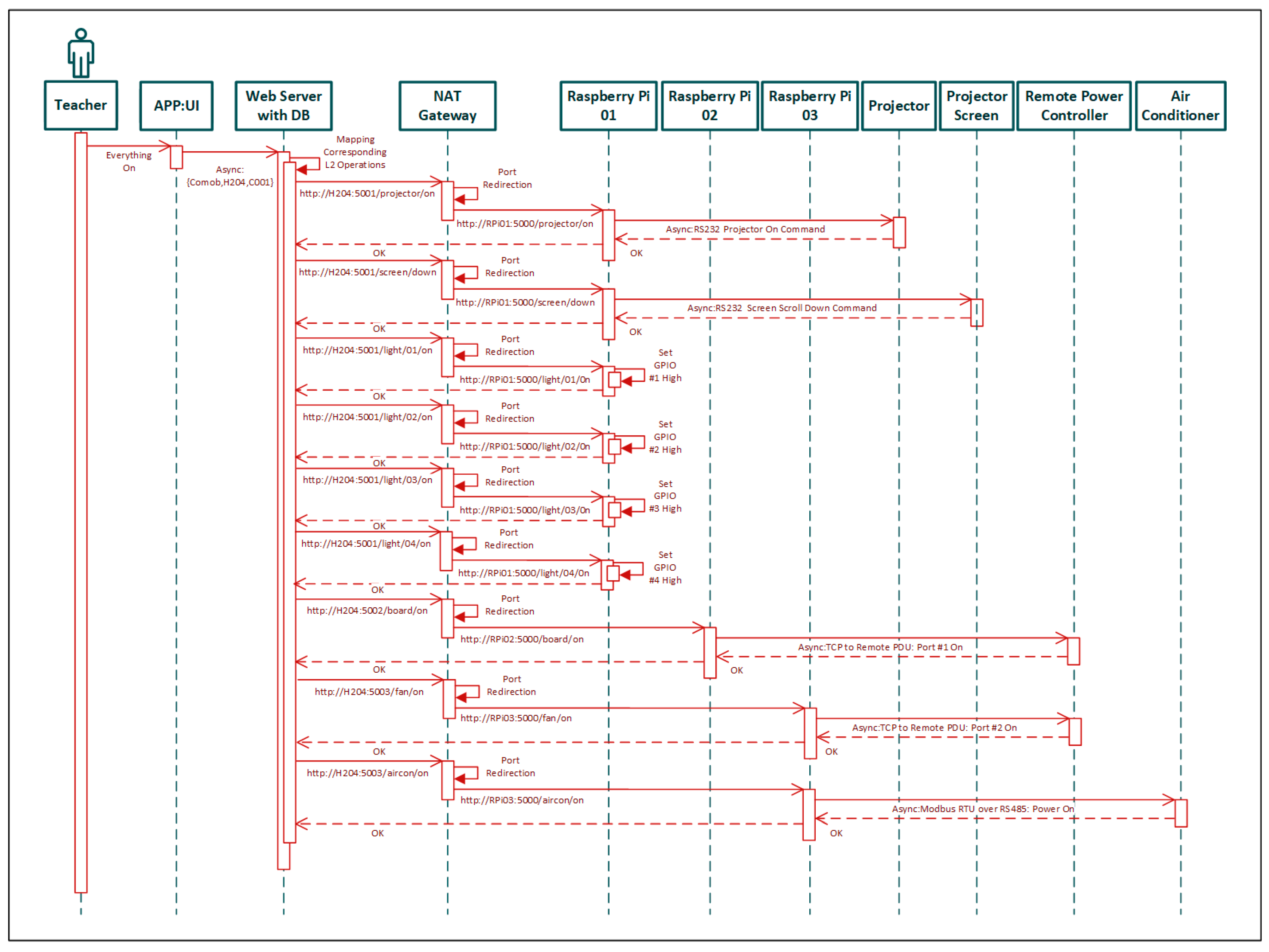
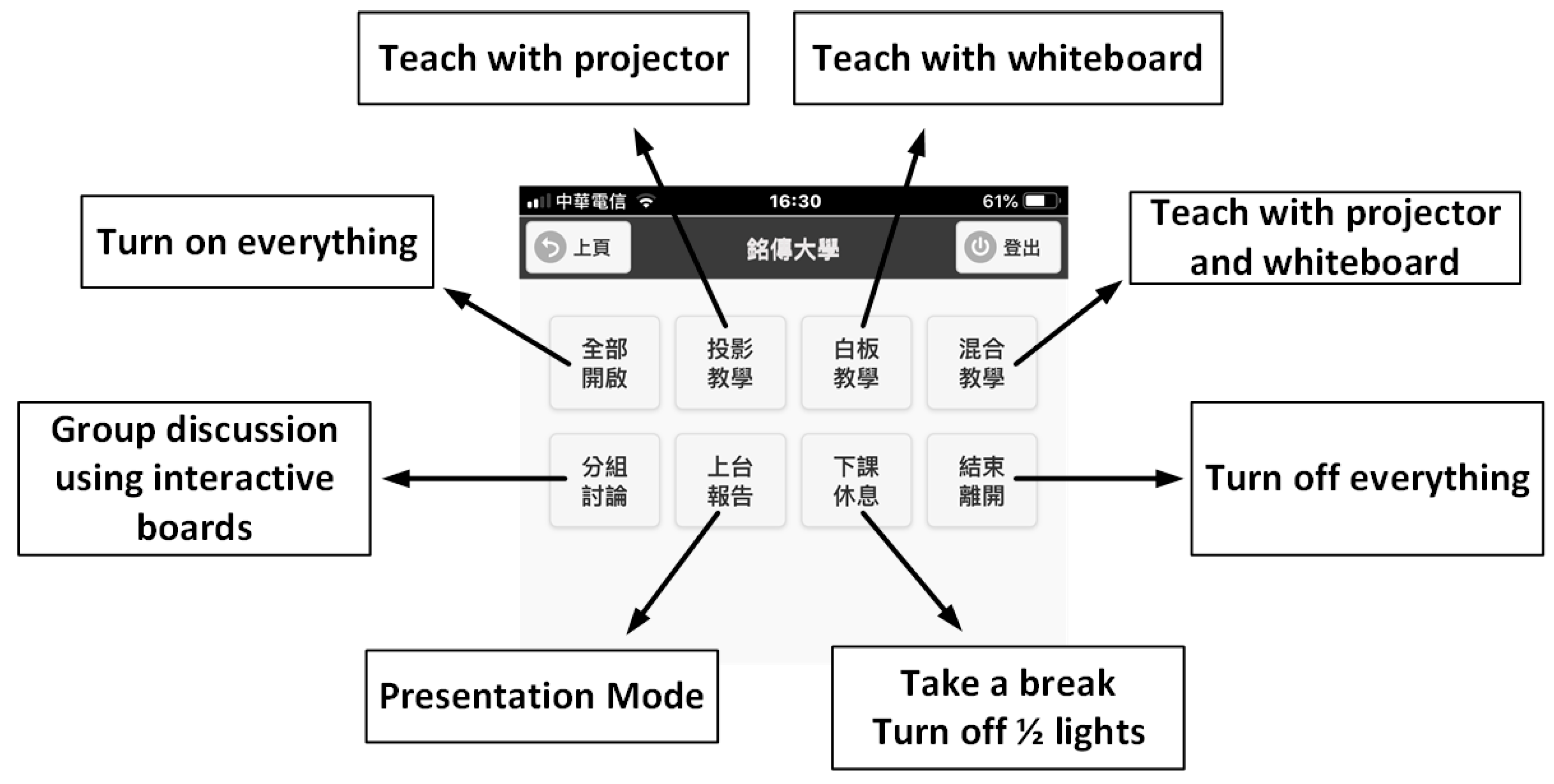


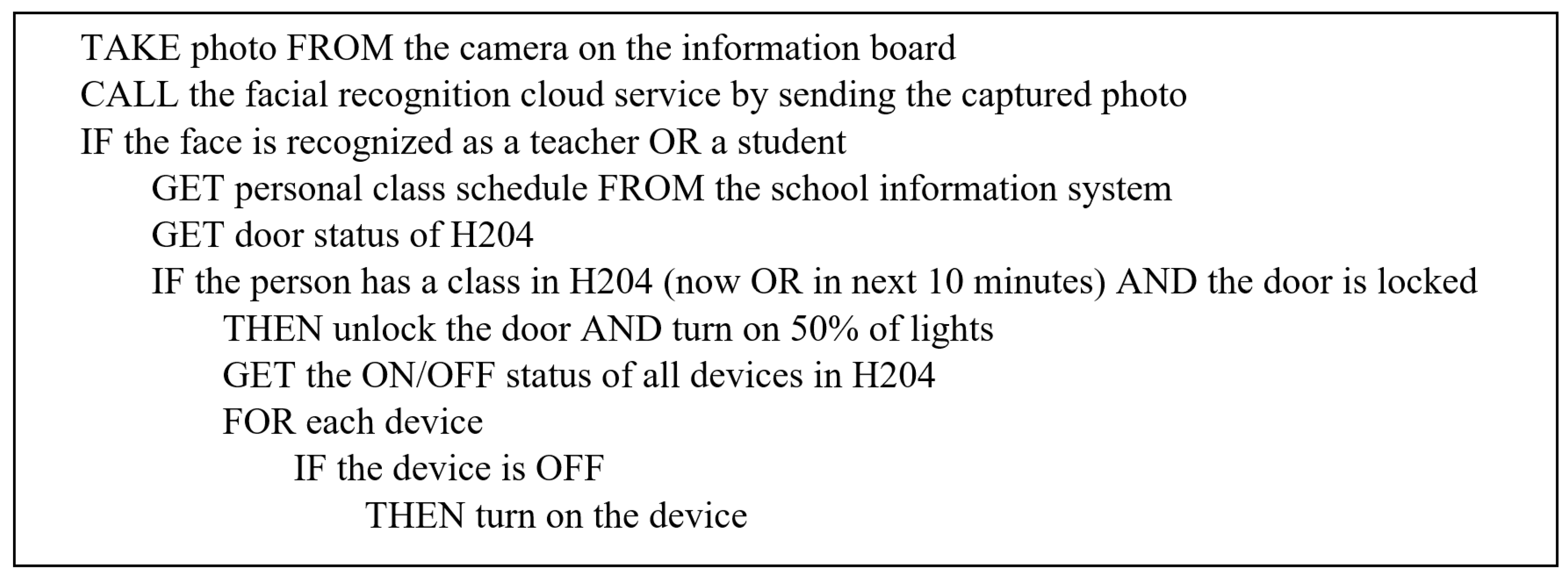



© 2019 by the authors. Licensee MDPI, Basel, Switzerland. This article is an open access article distributed under the terms and conditions of the Creative Commons Attribution (CC BY) license (http://creativecommons.org/licenses/by/4.0/).
Share and Cite
Huang, L.-S.; Su, J.-Y.; Pao, T.-L. A Context Aware Smart Classroom Architecture for Smart Campuses. Appl. Sci. 2019, 9, 1837. https://doi.org/10.3390/app9091837
Huang L-S, Su J-Y, Pao T-L. A Context Aware Smart Classroom Architecture for Smart Campuses. Applied Sciences. 2019; 9(9):1837. https://doi.org/10.3390/app9091837
Chicago/Turabian StyleHuang, Li-Shing, Jui-Yuan Su, and Tsang-Long Pao. 2019. "A Context Aware Smart Classroom Architecture for Smart Campuses" Applied Sciences 9, no. 9: 1837. https://doi.org/10.3390/app9091837
APA StyleHuang, L.-S., Su, J.-Y., & Pao, T.-L. (2019). A Context Aware Smart Classroom Architecture for Smart Campuses. Applied Sciences, 9(9), 1837. https://doi.org/10.3390/app9091837





